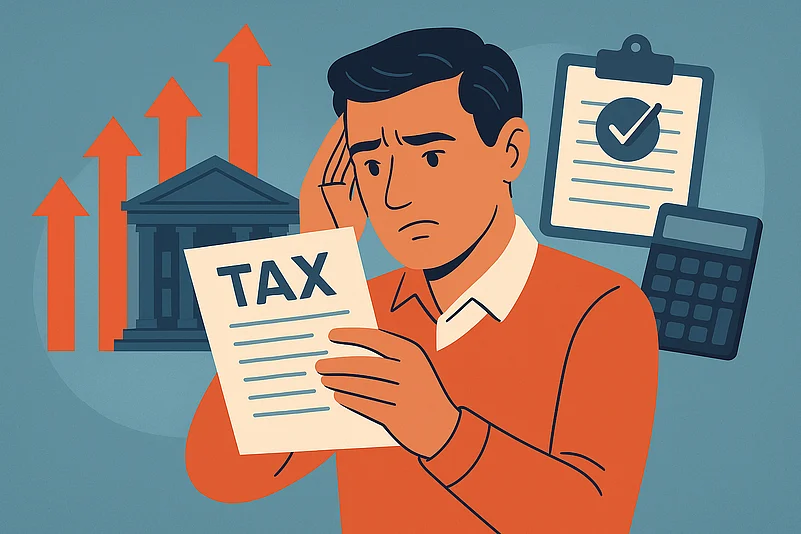
Summary of this article
Automated 143(1)(a) notices rising due to stricter AIS-ITR mismatches.
Near-zero-tolerance algorithms flag interest, dividends, ESOPs, and capital gains.
High-value deposits and remittances often trigger system-generated tax adjustments.
Salaried taxpayers must reconcile AIS, TDS, and investments before March 2026.
More salaried taxpayers are receiving automated income-tax notices in 2025 as the department’s data-matching algorithms become stricter. Even small mismatches between Form 26AS/AIS and salary details, employee stock exchange option (ESOP) sale proceeds, freelance side income, overseas remittances, or high-value credit card expenditures are now triggering system-generated alerts with no manual review.
Many employees are unaware that perquisites, reimbursements, stock payouts, or missed tax deducted at source (TDS) entries can create red flags.
The Real Triggers Behind 143(1)(a) Notices
“The most frequent triggers for automated notices under Section 143(1)(a) of the Income-tax Act, 1961 (“Act”) in the current assessment cycle are mismatches in the following,” says Tanmay Banthia, partner, TARAksh Lawyers and Consultants.
First, the interest income from savings accounts and fixed deposits reported in the Annual Information Statement (AIS) and Form 26AS. Second, dividend income was not properly grossed up or disclosed. Third, perquisites from Employee Stock Exchange Options (ESOPs)/Restricted Stock Units (ESOP/RSU) are taxed under Section 17(2)(vi) of the Act, where tax deducted at source (TDS) deduction or reporting by the employer is incomplete; fourth, professional/freelance receipts reported by deductors/platforms under Statement of Financial Transactions (SFT)—but omitted or under-reported in the Income Tax Return (ITR).
Fifth, capital gains on securities where AIS reflects sale proceeds but the return shows incorrect cost of acquisition, indexation, holding period, or complete non-reporting; and finally high-value cash deposits, credit card expenditure, or outward remittances flagged in taxpayer Information Summary (TIS) and treated as unexplained credits under Sections 68/69 read with Section 143(1)(a)(vi) of the Act.
“Having said that, several of these triggers arise from persistent reporting errors by banks and deductors rather than taxpayer fault, yet the system presumes taxpayer liability without differentiation, leading to widespread harassment for bona fide assesses,” says Banthia.
Why Automated Tax Demands Are Suddenly Spiking
The sharp increase in system-generated intimations results from the complete rollout of machine-learning-based risk scoring within the AIS-TIS framework by the Central Processing Centre (CPC).
“These upgraded algorithms apply near-zero tolerance thresholds, perform instantaneous multi-source matching (Form 16, Form 26AS, SFT returns under Section 285BA, high-value transaction reports under Rule 114B–114E, and foreign remittance data under the Liberalised Remittance Scheme), and issue demands under Section 143(1)(a) of the Act without any human intervention,” says Banthia.
All the relevant authorities, like banks, non-banking finance companies (NBFCs), credit card networks, mutual fund platforms, brokerages, employee provident fund organisation (EPFO), foreign tax authorities, and fintech remittance providers, need to provide the data to the Income Tax Department, which is linked to the PAN. Now, any mismatch in the data in AIS and ITR is flagged, and a system-generated notice is sent.
“Also, the volume of notices has surged because the Income-Tax Department is now using real-time, AI-driven, zero-tolerance matching across all data sources—generating automated alerts even for the smallest discrepancies, without any human involvement,” says Deepak Kumar Jain, Founder and CEO of TaxManager.in - the tax advisory and e-filing portal.
Essential Tax Fixes Before March 2026
“To prevent automated adjustments, interest, and penalties, salaried taxpayers must complete the following reconciliations before the updated return deadline in March 2026: First, reconcile TDS credits in Form 16/16A with Form 26AS/AIS and submit online feedback on the compliance portal for discrepancies,” says Banthia.
Second, upload supporting documents (rent receipts and landlord PAN where required under Rule 2A) for House Rent Allowance (HRA) exemption. Third, reconcile capital gains with statements from brokers/demat accounts and AIS transaction history.
Fourth, disclose foreign assets, foreign income, and remittances in Schedule Foreign Assets (FA)/Foreign Source Income (FSI) and file Form 67 for foreign tax credit where applicable. Fifth, verify ESOP/RSU perquisite valuation and TDS deduction with employer records, and review all high-value transactions flagged in the taxpayer information summary (TIS).










